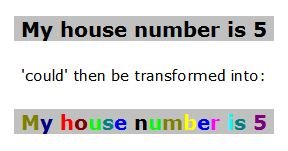 ‘IF’ someone had ‘natural’ COLOUR vision issues you would expect this to impact their entire ‘visual’ spectrum or more rarely specific areas of the eye. Read wikipedia colour blindness page for an overview of these possibilities.
‘IF’ someone had ‘natural’ COLOUR vision issues you would expect this to impact their entire ‘visual’ spectrum or more rarely specific areas of the eye. Read wikipedia colour blindness page for an overview of these possibilities.April 19, 2016
"Earth as a Simulation Series 4: This Series offers MANY pages of Evidence that many Anomalous Experiences, Plus 'Exceptional' Abilities & Skills can be explained 'IF' we are Simulated copied people being Simulated with Less Advanced Technologies resulting in ourselves having Anomalous Experiences that relate to Hi-Tech Neural Implants & CNS Enhancements that the person we are simulating HAD, but which we are a long way from developing here!!!"
It is highly likely that neural implants that are spliced into sensory input feeds would handle and also manipulate the ‘sensory’ data ‘digitally’. Specifically it is highly likely that many neural implants would DIGITISE sensory input AND for many implant functions this now digitised data would be manipulated, processed and for specific ‘applications’. In other words, any ‘perceived’ visual scene could be specifically altered and changed before being passed on and directly ‘experienced / viewed’.
Can you reading this spend time ‘NOW’ trying to imagine just ‘some’ of the utterly bizarre ‘weird’ DIGITAL EFFECTS that these types of neural implant originated digital conversions could result in and particularly for very specific types of neural implant that would depend on and process visual input and or which would use vision to present their output?
For example, digitised visual / eye sight input and particularly of visual ‘views’ that include ‘text’ are likely to automatically have optical character recognition (OCR) software permanently active. OCR software specifically identifies written text character by character, it could even identify which font the text is using. In other words OCR software specifically identifies each and every individual character in digitized documents.
Once OCR software within a neural implant identifies a written character it would then be easy to apply alterations, overlay masks and even ‘substitutions’ to any characters that it isolates / identifies. For example it would be stupidly easy for a ‘vision’ focused neural implant with a built in OCR function to be able to identify and to then ‘highlight’ or apply an ‘overlay’ or a ‘transformation’ to any character such that each ‘letter or number’ character is then output in say a specific colour.
 ‘IF’ someone had ‘natural’ COLOUR vision issues you would expect this to impact their entire ‘visual’ spectrum or more rarely specific areas of the eye. Read wikipedia colour blindness page for an overview of these possibilities.
‘IF’ someone had ‘natural’ COLOUR vision issues you would expect this to impact their entire ‘visual’ spectrum or more rarely specific areas of the eye. Read wikipedia colour blindness page for an overview of these possibilities.
Having absolutely anyone, even one person in the population consistently exhibiting visual presentations of letters and or numbers and particularly were any ‘character’ is consistently presented as a specific colour, AND ‘always’ that same colour, you’d imagine would . . .
That you would imagine that under these circumstances ‘someone’ somewhere would have queried how an assumed ‘natural’ organic ‘EYE’ could have evolved to automatically dynamically ‘apply’ consistent ‘digital’ transformation effects in unbelievably ‘specific’ ways AND consistently to very specific viewed shapes ‘coincidentally’ only found in written text?
Coincidentally, there is a well documented condition called ‘Synesthesia’, which is a cover all term for many different individual, consistent but bizarre variations of what are essentially described as ‘mixed up senses’.
On wikipedia’s ‘synesthesia’ page one of the many sub conditions is called grapheme-color synesthesia which gives the following description:
“In one of the most common forms of synesthesia, individual letters of the alphabet and numbers (collectively referred to as graphemes) are “shaded” or “tinged” with a colour. While different individuals usually do not report the same colours for all letters and numbers, studies with large numbers of synesthetes find some commonalities across letters (e.g. A is likely to be red).”
Two, very interesting examples are given for this condition which indicate that grapheme-colour synesthesia effects are DYNAMIC, meaning that they are ‘INTELLIGENTLY’ RESPONSIVE in a MOMENT BY MOMENT SENSE.
1. As a child, Pat Duffy told her father, “I realized that to make an R all I had to do was first write a P and draw a line down from its loop. And I was so surprised that I could turn a yellow letter into an orange letter just by adding a line.”
2. Another grapheme synesthete says, “When I read, about five words around the exact one I’m reading are in colour. It’s also the only way I can spell. In elementary school I remember knowing how to spell the word ‘priority’ (with an “i” rather than an “e”) because … an ‘e’ was out of place in that word because ‘e’s were yellow and didn’t fit.”
In other words, for this particular ‘condition’ for both of the above people it ‘coincidentally’ and unbelievably functions as a:
Did you notice that for my ‘My house number is 5’ example I used a grey background?
This is because on a ‘standard’ white background it’s difficult to just ‘automatically’ read and ‘naturally’ comprehend what is written . . .
The ‘example’ graphic on the wikipedia page is also VERY revealing in this respect too, here it is below . . .
Compare the above to this ‘normal’ text version below:
Basically, you realise that UNBELIEVABLY, using slightly ‘blurred’ darker text when presenting coloured letters & numbers makes it much easier to read than ‘normal’ text. Coincidentally, people experiencing grapheme-colour synesthesia actually see the highlighted characters in a blurred, ‘easier to see and read’ form.
In another ‘experience’ description from here, we have more evidence of grapheme-colour synesthesia effects being correlated with helping people spell words correctly:
“Grapheme-colour synesthesia helps with memorization and recall of both numbers and words, due to the unique colour coding associated with each word or number. For example, homonyms such as “break” and “brake” evoke very different colour sensations within the mind of a synesthete, making it even simpler to distinguish between the two than through the distinction of spelling alone.”
The only conclusion that you can ‘realistically’ come to is that the specific effects described by these examples ‘coincidentally’ all help to maximise ‘facilitated’ writing, spelling, comprehension, memory retention and recall of what is written. Basically, many personal experience examples of those that have grapheme-colour synesthesia offer consistent evidence that ‘some’ people here have the ‘abilities’ that you would ‘expect’ if they had a writing, composition and spelling facilitating neural implant wired directly into their head.
On this site here I found a list of general synesthesia characteristics (I’ve added my own underlined ‘extension’ for one of the points in this list)::
Basically, grapheme-colour synesthesia describes an entire set of highly anomalous ‘automatic’ (not consciously invoked) abilities and skills. These extended abilities, skills and ‘functioning’ (on the whole) could actually be described as examples of human ‘enhancements’. In fact, one of the pages linked above makes a point of stating that synesthesia is not listed in either the DSM-IV or the ICD (as a neurological condition) since it most often does not interfere with normal daily functioning. In other words, these ‘experiences’ are not taken as being something ‘bad’ such that efforts must be made to ‘correct’ or eliminate them.
If we were to appraise the grapheme-colour synesthesia experiences in terms of our entire KNOWLEDGE BASE then we might find ourselves being able to state that, grapheme-colour synesthesia experiences and the consistent personal descriptions of these give the VERY STRONG IMPRESSION that they are actually describing some sort of BUILT IN spelling, language and writing comprehension learning aid.
Is this possible? How would we ‘rationally’ approach THINKING about this possibility in more depth?
Well, we could IMAGINE OURSELVES as being the hypothetical designer of a hypothetical language, writing comprehension and spelling aid neural implant and JUST FOR FUN we could evaluate these experiences as potentially being due to the functioning of a neural implant enhancement AND in THINKING about these possibilities we could then ask ourselves WHAT ELSE WOULD ‘LIKELY’ BE INCLUDED AS PART OF THE FUNCTIONING OF SUCH AN IMPLANT? What other functions would YOU design into a hypothetical writing, composition, language comprehension and spelling enhancement and particularly one that was being designed for use by young children?
Well, at an extreme (for the; ‘high end, no expense spared’ neural implant version) you might design such an enhancement to automatically transform alphabet letters and maybe numbers into ‘memorable’ as well as language and alphabet ‘meaningful’ cartoon characters!!!
As a hypothetical language, writing and spelling aid implant designer you could IMAGINE people using these ‘extra’ functions and you could then think about the types of ‘experiences’ that these ‘extra’ functions would result in? You could then look through the descriptions of grapheme-colour synesthesia experiences to see if anyone’s described experiences that match with what you can ‘deduce’ would be LIKELY for such an implant.
‘Unbelievably’ some people do see each letter in the form of a cartoon ‘character’ type person. The graphic below (taken from here) are the actual characters drawn from the descriptions given by someone with synesthesia whom consistently sees each letter as a cartoon type character some of which are presented below.
On that page, each of the cartoon characters ‘representing’ each LETTER of the alphabet is given a description written by someone that DOES actually see written letters in this form. Each ‘character’ in the above line up also has a distinct personality to.
For example the letter ‘I’ has the following BUILT IN attributes: Gender: Female, Colour: White, Personality: Meek, cautious, quiet, soft spoken, dreamer.
Now, in thinking about ‘everything’ above and spending time looking at the ‘characters’ (that we are ‘unbelievably’ expected to imagine that someone’s head has sub consciously ‘automatically’ picked to represent a specific written LETTER of the alphabet as in a ‘CHARACTER’ (of the alphabet)) then if this ‘IS’ part of some writing, spelling, learning aid neural implant then the characters are likely to be given names that will help in this way, i.e. they will facilitate understanding of the letters, their characteristics and even perhaps their ‘place’ in the alphabet (and often names that young kids would identify with / remember). For example:
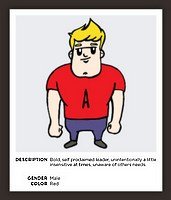 ‘A’ has defined attributes of: Male, RED: “Bold self proclaimed leader, unintentionally a little sensitive at times, unaware of others”.
‘A’ has defined attributes of: Male, RED: “Bold self proclaimed leader, unintentionally a little sensitive at times, unaware of others”.
The cartoon person representing ‘A’ is given a highly visible colour AND is visibly Athletic, in other words letter ‘A’ is represented by a BIG ‘Alpha male’ type, i.e. someone that would symbolically ‘BEST’ represent the ‘LEADER’, in this case, the first or LEAD character in the ALPHAbet. In other words, the cartoon character ‘A’ is likely named/called ‘Alpha’.
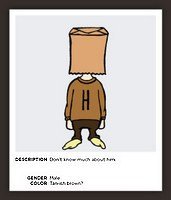 ‘H’ has defined attributes of: Male, Tan-ish Brown: “Don’t know much about him.”
‘H’ has defined attributes of: Male, Tan-ish Brown: “Don’t know much about him.”
The latter ‘H’ is found in words such as ‘Through / The / Them / Ought’ in other words, the ‘H’ character as in ‘heych or huu’ is often unexpressed i.e. verbally ‘H’ is actually often ‘Hidden’ within words, also the black ‘H’ on the brown background on the T-shirt of the figure above makes the ‘H’ one of the most ‘visibly’ obscured of the cartoon characters to, never mind that he’s got a completely obscuring bag over his head. The cartoon character ‘H’ is likely named ‘Hidden’.
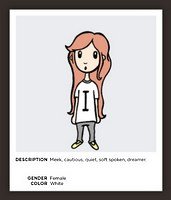 ‘I’ has defined attributes of: Female, White: “Meek, cautious, quiet, soft spoken, dreamer.”
‘I’ has defined attributes of: Female, White: “Meek, cautious, quiet, soft spoken, dreamer.”
The letter ‘I’ in being just one single vertical line could actually best be described as the most invisible letter of the alphabet. White is also the most ‘blend in’, nondescript, essentially ‘bland’ colour. Also, the cartoon person representing ‘I’ is also ‘THE’ thinnest character in the above line up. In other words the letter ‘I’ character is probably called ‘Invisible’.
Are we supposed to believe that, ‘all that I point out on above’, which you can deduce would be appropriate for and EXPECTED of a sophisticated writing, reading, spelling and written ‘comprehension’ learning aid neural implant are all just ‘RANDOM COINCIDENCES’?
Below are comments I’ve found on various web sites that actually somewhat ‘extend’, beyond what I have laid out above:
Some people also appear to have ‘spell checking’ built in even for different languages (from comments on here):
“When someone speaks to me in whatever language I am fluent in, I can ‘see’ the words written in my mind, like if I was reading their speech ?? I’ve been doing that ever since i was little, maybe 3 or 4 years old (I started to read and write at that age) and it never stopped. I don’t usually make spelling mistakes in a language because of that. Also, when I hear a new word, it’s automatically written correctly in my head. It’s weird, I feel like a dictionary – hahaha”
The comment below (from comments on here) is of someone that has dyslexia who didn’t notice that this was the case because the synesthesia compensated for this somewhat. Because of the synesthesia they can also speed read because what is written is translated into a moving picture that represents the meaning of what is written.
Any ideas as to how an assumed flesh and blood human ‘head’ could generate these types of sophisticated visual data manipulation skills?
“I have Synesthesia, but I also have Dyslexia. I didn’t realize I had either until later in High School because the Synesthesia translated the letters and words into colors, so I didn’t have to see the individual letters themselves. This only became a problem when the colors of the words was almost the same. For example, immortal is a pinkish-purple and immoral is two shades more purple. I have also noticed that the Synesthesia has turned me into a speed reader. For example, a trained speed reader (my sister) can divide the page into six sections and then read the different sections and then their brain puts the words into coherent order for them. I realized that I divide the page in half and look at the sequences of colors (words) on the top half, then the bottom half, then the meaning comes alive in my head in the form of a moving picture. It’s just really interesting.”
There are two ‘strange’ things that I’ve noticed on the web pages I’ve read that discuss and also present ‘tests’ for those with grapheme-colour synesthesia. All, ‘tests’ of grapheme-colour synesthesia in terms of different characters being different colours ALL present the text in ‘digital’ form, with all of the characters in the ‘as expected’ upright orientation.
For anyone that has scanned a text sheet into a computer to have it converted into an editable document will appreciate how ‘finicky’ Optical Character Recognition (OCR) software actually is.
Basically, if the paper is not very ‘approximately’ up/down vertical then the software has problems identifying characters, with the result that any scanned pages that are significantly ‘skewed’ can result in entertaining but completely wrong character conversions.
So, my ‘enquiry’ here is, how well, how consistently and ‘accurately’ are the black text characters of the following ‘converted’ into the colours and or the cartoon characters as you’d ‘expect’?
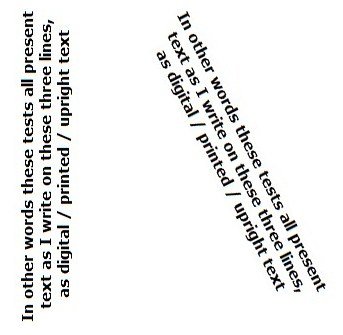 Grapheme-Colour Synesthesia ‘Digital’ Test 2: Recognition of digital as opposed to cursive/natural text and at different angles ‘test’:
Grapheme-Colour Synesthesia ‘Digital’ Test 2: Recognition of digital as opposed to cursive/natural text and at different angles ‘test’:
Can all of these reading this page that have grapheme-colour synesthesia leave comments to let us all know:
For neural implants that originate within a high technology society, I’d expect people to ‘write’ in ‘digital’ text by sub-vocally or subliminally dictating the words of the text they want recorded to have this done (for e-mails, twitter, Facebook, diary entries, VR site comments etc). I’d then personally expect such a neural implant to preferentially handle text in a DIGITAL form and not ‘natural’ text.
Before reading the next page, can you think of any of the neural ‘implant’ possibilities that I already mentioned on the previous pages and then imagine what else would we expect in specific ‘word’ presentation terms that would also be evidence that we are simulating people with neural implants?
Hint, perhaps have a ‘think’ about the possibilities you would ‘expect’ of a neural implant that functions as a diary and which then might handle scheduling and maybe even offer a ‘to do list’?
Click the right >> link below for the next page in this series . .
Filed under Human Enhancements & Implant Anomalies